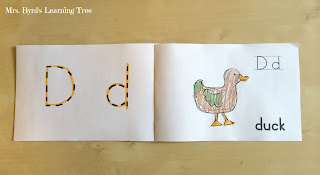This is the first of several upcoming posts on how I teach letters and sounds in my classroom. So, first things first, if you are teaching kindergarten, please tell me that you don't do letter of the week anymore! I was soooo glad to read this on Cara Carroll's blog too! I have been thinking it for years now, thank goodness someone just put it right out there. Kindergarten kids need to have a working knowledge of letters and sounds by the end of the first trimester in order to meet grade level expectations for the end of the year. So, teaching letters weekly just doesn't work.
OK, so... time for true confessions. Even just a few years ago, I was still doing a poem each week that had a letter reference and activity with it. Although it wasn't really a "letter of the week" program, I finally came to the realization that it wasn't appropriate any more. By the second half of the school year, my students were so "beyond" the letter work, I was feeling bad. It's hard sometimes, as teachers, when we see the value in certain activities, but we know that it is time to move on. Well, I finally moved on.
So, I tweaked my alphabet program a bit. Instead of a weekly poem book, my students make a little ABC emergent reader. It is one of the first books they learn to read. Not only does it help internalize letter names and sounds, but it also helps my students learn to handle books, point as they read, understand directionality with text, and it makes them feel confident as readers. Woo hoo! That's why I love these little books and am happy I made the shift to these.
These books are VERY simple. You could easily make them yourself by drawing out the pages (wink, wink). If you have the time and inclination to do that, go for it! This is not an original idea. But, if you don't have the time to make them yourself, you can go get these in my TpT store: ABC Book! Student made Emergent Reader for Letter Learning
I have my kiddos do a page each day as a center activity for the first few weeks of school. It is nice to have an activity that they feel comfortable doing as we are learning routines and setting expectations. For each letter, I set out lots of matching picture cards like these (ABC Cards! Letter matching cards for learning) . I am also in the process of teaching my kinesthetic alphabet to them at the same time. We are also reading lots of alphabet books. We are doing lots of hands on activities with tactile letters. They are getting immersed with letters as we make these books.
The important thing about this book, is that students choose what picture they will draw for each letter. When the child chooses, she will usually pick something that she has already associated with that letter and sound. This creates a STRONG connection between letter and sound. It helps students master letters and sounds quickly. It has been working well in my classroom. That is why I am finally sharing this with you. I have had proven success with this. (...and I finally made it into an actual product I can share... ha ha!)
You get the idea. There are also pages with the pictures and words already on them. Those are for TK or preschool sweeties. Here are a couple of those:
So the pre-K pages do not require drawing, just coloring. I used these with my TK students last year and they were perfect. The pictures are aligned with my Kinesthetic Alphabet. What is a kinesthetic alphabet, you ask? Well, that is a whole other blog post. So, keep posted. It is coming soon.
I hope this idea helps you to teach the alphabet in your classroom this year. Stay tuned for future posts on this topic. Letters and sounds are such an important foundation in literacy. So, it is something we need to share and talk about. If you want to use this little book in your classroom, you can get it on my TpT shop. Just click on the image below:
If you have some great ideas for how you teach letters in your classroom, leave a comment below. I hope we can get a little conversation going. Let's share best practices to help make us all better teachers.
Happy teaching!











No comments:
Post a Comment